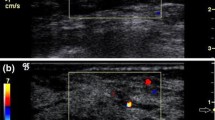Abstract
The ‘twinkle’ or ‘twinkling’ artifact represents a phenomenon observed using color Doppler ultrasound that leads to a rapid alternation of color in and immediately behind an echogenic and highly reflective object. It occurs during sonographic examination of kidney stones, and has been also described in clips used for marking breast and axillary lesions.
Similar content being viewed by others
Avoid common mistakes on your manuscript.
While the exact nature of this artifact remains poorly understood, it may prove useful when localizing a clip, for example for a targeted axillary dissection (TAD) in breast cancer patients receiving neoadjuvant chemotherapy (NACT). This surgical technique consists of the removal of a target lymph node, i.e., a biopsy-proven and marked node, and sentinel node biopsy, and can be offered patients converting from positive to negative node status through NACT (cN + → ycN0). Usually, the target node is marked using a clip/coil, but other probe-guided detection techniques, such as magnetic or radar localization, may be used as well [1]. In case a clip has been placed into the node, its detection depends mainly on its reliable ultrasound visibility. For this reason, larger clips and those with a 3D shape or hydrogel carrier are often chosen, but the ultrasound detection rate remains lower than expected (approx. 70–90% in previous studies). Therefore, additional tools such as the twinkle artifact may help to identify the clip. However, not all clip types produce this artifact, so the documentation of exact clip type and shape is recommended (Fig. 1).
Two different clips shown in B-mode (upper row) and using color Doppler (lower row). Left: small cavernous hemangioma, confirmed by core-biopsy with synchronous clip placement. The visible lesion with the clip was localized intraoperatively via ultrasound without the necessity for a preoperative localization step with, e.g., a wire. Right: core-biopsy confirmed breast cancer with complete remission upon imaging. The clip was placed before start of neoadjuvant chemotherapy
Reference
Banys-Paluchowski M, Gasparri ML, de Boniface J, Gentilini O, Stickeler E, Hartmann S, Thill M, Rubio IT, Di Micco R, Bonci EA et al (2021) Surgical management of the axilla in clinically node-positive breast cancer patients converting to clinical node negativity through neoadjuvant chemotherapy: current status, knowledge gaps, and rationale for the EUBREAST-03 AXSANA study. Cancers (Basel). 13(7):1565
Funding
Open Access funding enabled and organized by Projekt DEAL.
Author information
Authors and Affiliations
Contributions
MBP, PP, and NK have obtained the images and wrote the description. All authors read and approved the final manuscript.
Corresponding author
Ethics declarations
Competing interest
MBP received honoraria for lectures and advisory role: Roche, Novartis, Pfizer, pfm, Eli Lilly, Onkowissen, Seagen, AstraZeneca, Eisai, AstraZeneca, Amgen, Samsung, MSD, GSK, Daiichi Sankyo, Gilead, Sirius Pintuition, Pierre Fabre, and study support from: EndoMag, Mammotome, and MeritMedical. PP and NK declare no conflicts of interest.
Ethical approval
Not applicable.
Consent to participate
Not applicable.
Consent to publish
Not applicable.
Additional information
Publisher's Note
Springer Nature remains neutral with regard to jurisdictional claims in published maps and institutional affiliations.
Supplementary Information
Below is the link to the electronic supplementary material.
Supplementary file1 (AVI 1557 KB)
Supplementary file2 (AVI 11184 KB)
Rights and permissions
Open Access This article is licensed under a Creative Commons Attribution 4.0 International License, which permits use, sharing, adaptation, distribution and reproduction in any medium or format, as long as you give appropriate credit to the original author(s) and the source, provide a link to the Creative Commons licence, and indicate if changes were made. The images or other third party material in this article are included in the article's Creative Commons licence, unless indicated otherwise in a credit line to the material. If material is not included in the article's Creative Commons licence and your intended use is not permitted by statutory regulation or exceeds the permitted use, you will need to obtain permission directly from the copyright holder. To view a copy of this licence, visit http://creativecommons.org/licenses/by/4.0/.
About this article
Cite this article
Maggie, BP., Peter, P. & Natalia, K. Twinkle artifact in sonographic breast clip visualization. Arch Gynecol Obstet 307, 2021–2022 (2023). https://doi.org/10.1007/s00404-022-06659-1
Received:
Accepted:
Published:
Issue Date:
DOI: https://doi.org/10.1007/s00404-022-06659-1





